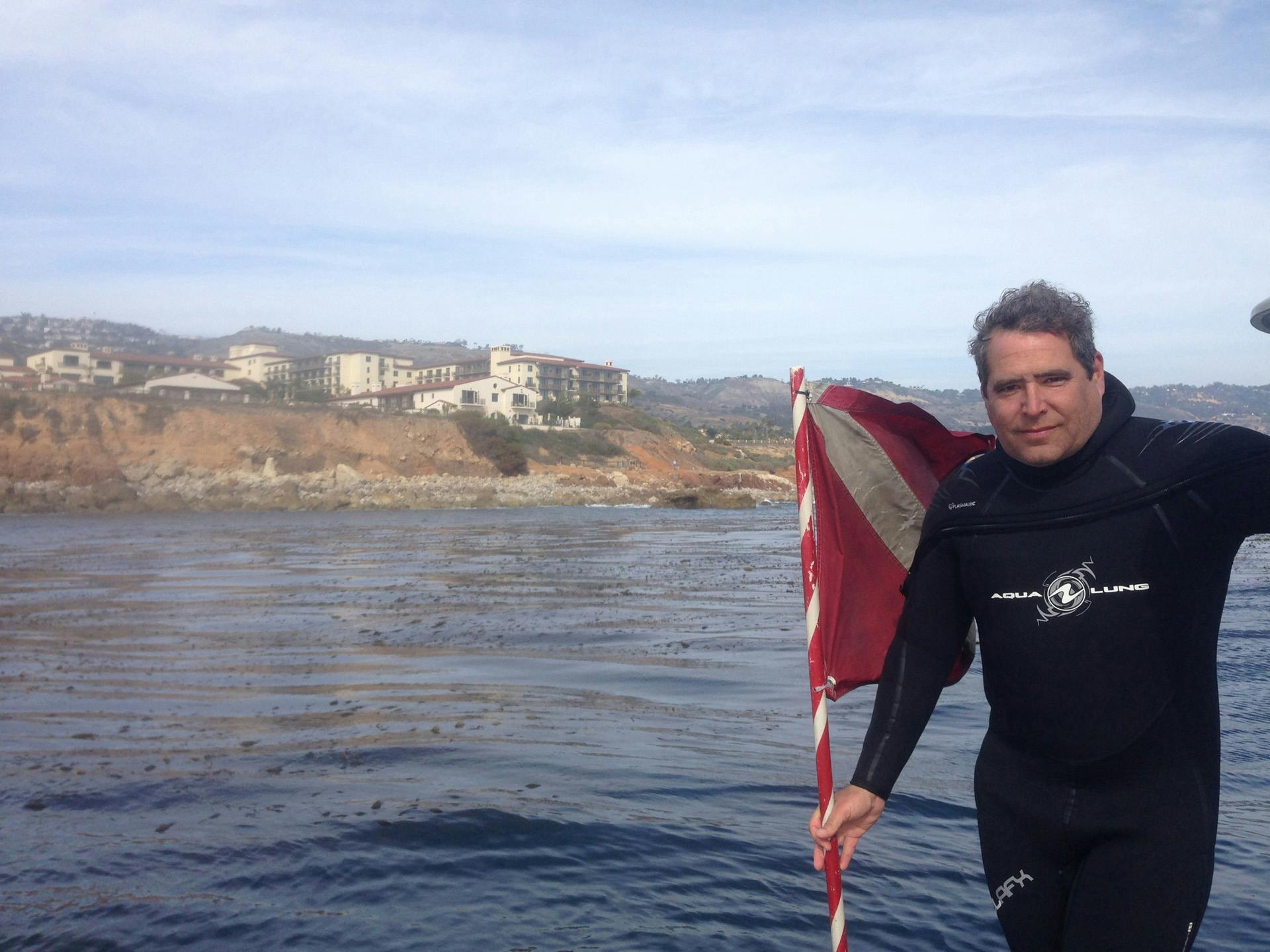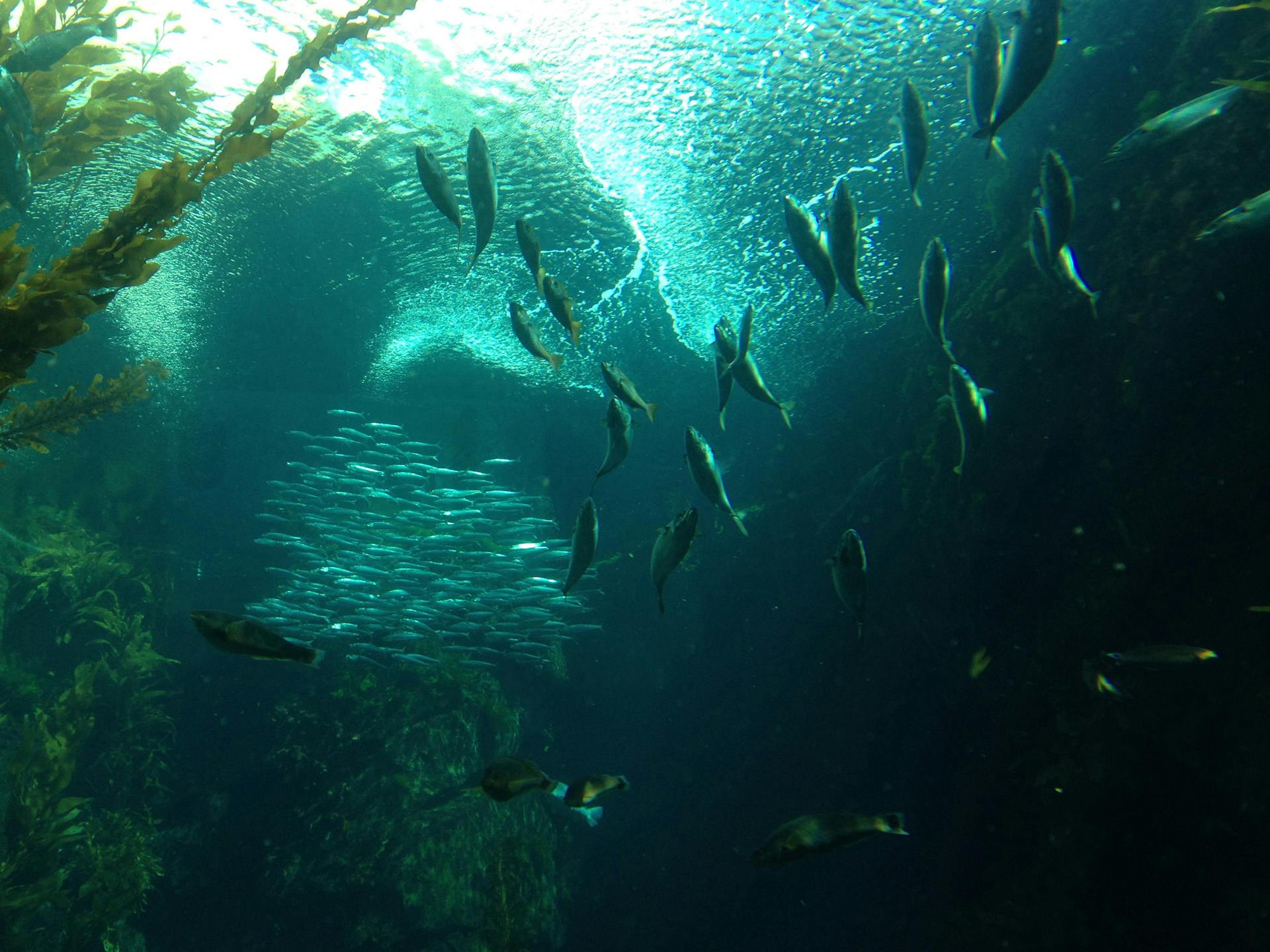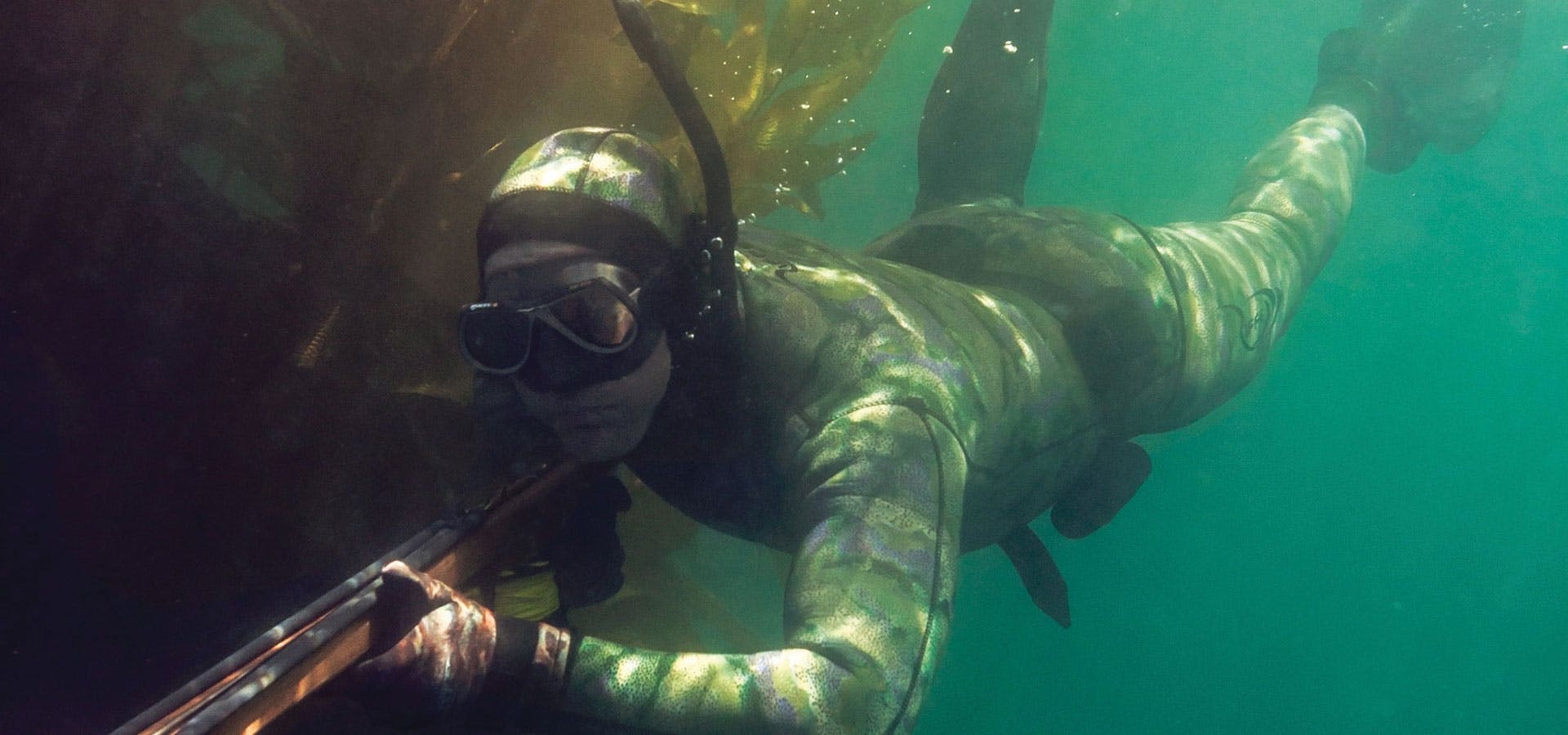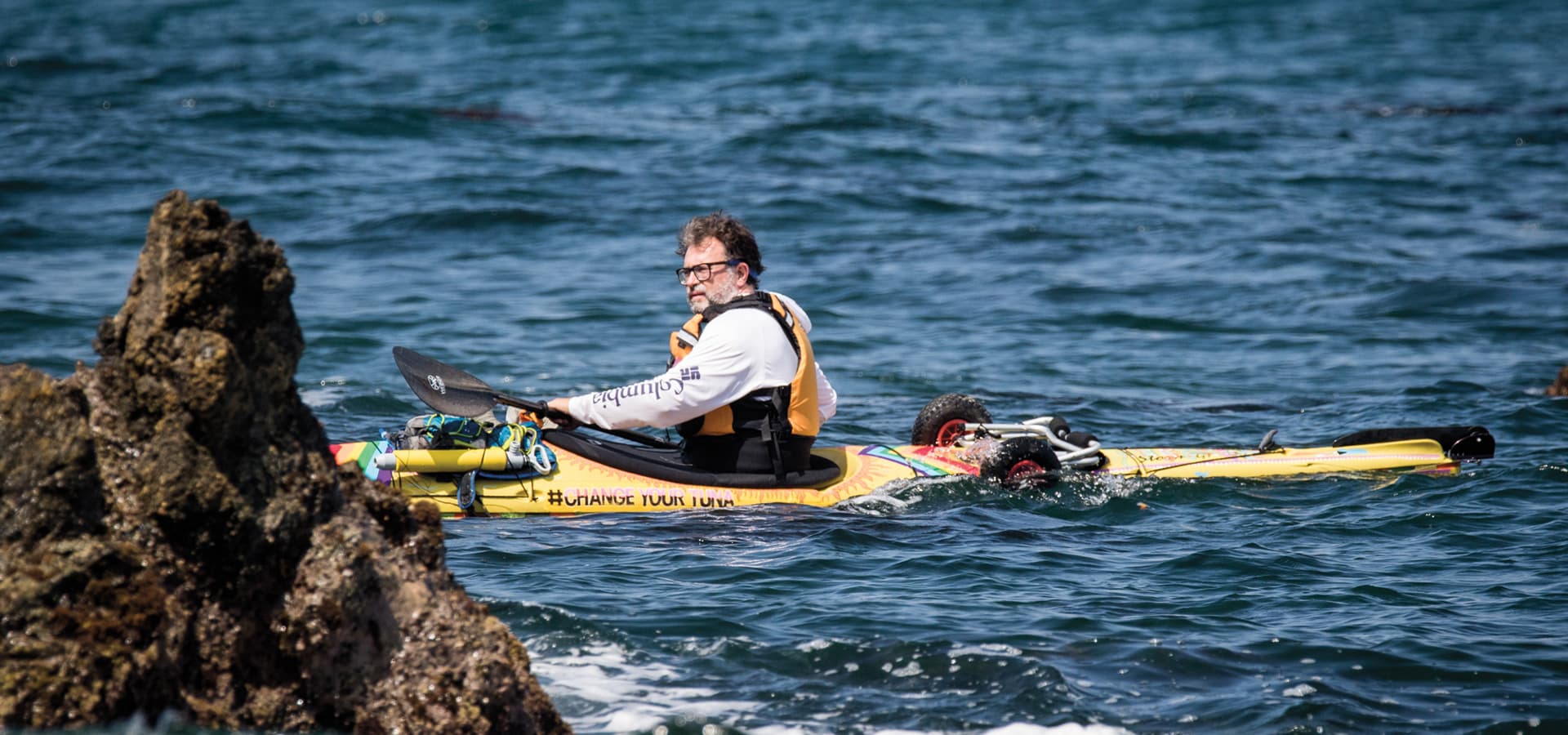Like all ecosystems, the ocean exists in a delicate balance: predators and prey, food supply and consumers—all inextricably linked in a self-supporting web. If even one element is removed, the whole is in danger of collapse.
The kelp beds off the coast of the Palos Verdes Peninsula, just beneath Terranea Resort, are home to more than 700 different species of aquatic life. One of the planet’s most diverse and thriving ecosystems, it is currently besieged by an onslaught of unlikely marauders: a California native, the purple sea urchin.
Well-known and well-loved by connoisseurs who devour the spiny invertebrates as uni at stylish sushi bars, these unlikely predators are threatening the kelp forests and the sea around them. Ironically, the spiky little beasts are slow-moving herbivores, but they can mow down entire forests with their spines and five-toothed mouths.
“The sea urchin population has exploded out of bounds in the absence of their natural predators,” explains Tom Ford, executive director of The Bay Foundation, a West Los Angeles-based organization established in 1990 to restore and enhance Santa Monica Bay, improve the quality of its waters, conserve its natural resources and wildlife habitats, and protect it for future generations. Tom is trained in biology and marine ecology, and he is an avid scuba diver. His knowledge and understanding of the ocean is both academic and intimate.

“Sea otters, which we associate mostly with Northern California and the Monterey Bay area, actually ranged all along the California coast, all the way down to Baja. In addition to being cute and adorable, they can also eat 20% of their body weight in sea urchins every day,” Tom explains.
The presence of the cute but voracious sea otters kept the sea urchin population in check until humans intervened. “Sea otters were hunted for their skins,” says Tom sadly. “It looks very smooth and sleek, but it is one of the densest furs that exist on the planet—very warm and waterproof. It was very popular in China and Russia for fur coats, collars, shawls and hats. They were hunted to the brink of extinction. It’s no longer legal to hunt them, but the species hasn’t rebounded completely. We see a few transiting through every year, but not in the previous numbers—and not enough of them to keep the sea urchin population under control.”
Without the sea otters and other predators limiting it, the sea urchin population has exploded out of control, devouring more than their fair share of the algae that also feeds other marine species and ravaging the kelp beds that are ordinarily both home and nourishment to a plethora of sea creatures. These seemingly innocuous creatures are sacking and pillaging the sea floor, endangering themselves and other marine life in the process.

Tom insists, “These sea urchins are not an invasive species. They are completely native and indigenous to the environment and ordinarily part of the naturally balanced ecosystem. But in the absence of the sea otters and other predators, their numbers explode out of control.”
This is not, however, a boon to sushi lovers. “When the sea urchin population is in balance, they average two per square meter of kelp forest,” Tom explains. “They feed on marine algae and underwater plants and have plenty of energy to grow fat and develop their gonads, which is what people eat as sushi. Without the sea otters, there are as many as 70 per square meter. There’s not enough food to support a healthy sea urchin population; they are undernourished and inedible.”
Sea urchin fishing is a multi-million dollar industry off the California coastline, according to The Bay Foundation website, and $6 million of that is produced locally. “A lot of the sea urchin harvest landed in Southern California stays here, but it also moves up the coast to San Francisco, Portland and Seattle,” says Tom. “If you order uni in Dallas, chances are it came from Southern California. We’re also exporting more and more to China, Japan and Korea.”
After 10 years of study, The Bay Foundation came up with a simple solution to restore the natural balance and health of the kelp forests off the coast of Palos Verdes and to assure the supply of plump, delicious uni to sushi lovers everywhere. Tom Ford and his team of scientists/divers have been carefully culling the excess sea urchin population one at a time by hand, eliminating the scrawny, sickly inedible specimen to make room for the healthy, strong sea urchins to survive, thrive and reproduce.

It’s a surprisingly low-tech process. “There are 20 people on my sea urchin eradication team,” says Tom. “We go out on small fishing boats, about six of them, averaging 35 feet in length. We go out on cold, rough seas when most people are not sailing. Divers go down to the kelp beds and thin out the sickly sea urchins.”
It is a slow and laborious process, but Tom and The Bay Foundation hope to restore 150 acres of underwater kelp beds below Terranea by the time the project is complete, and they will continue to monitor the kelp forests’ regrowth. “Regardless of global stress, climate change, etc., the balance of the ecosystem can be managed,” he insists.
The Bay Foundation’s work has attracted attention from scientists all over the world. “We have had visitors from Norway, Italy, Canada, Japan and New Zealand,” Tom says proudly. “They want to study our methods and apply them to their own ecosystems to help create sustainable models.”
It might be a gradual process, but the end results are worth it. “It’s not just good for the planet; it’s good for your plate, if you’re a uni fan!” Tom laughs.
He has spent thousands of hours restoring the kelp beds below Terranea. “I wish all my fellow scuba divers could see how beautiful it is,” he says. “What I enjoy most about being a Los Angeles resident is the opportunity to enjoy our beaches, our mountains and cliffsides. Seventy-two million people visit our beaches every year. I hope everybody who comes to our coast has as rich an experience as I have and gets to enjoy the gorgeous setting and diverse community of people who live and visit here.”

Tom and his colleagues at The Bay Foundation are passionately committed to preserving that beauty and biodiversity both beneath the waves and onshore. The kelp beds are not their only area of concern. The Bay Foundation is also involved in shoreline cleanup, restoring the sand dunes off LAX, creating sand dunes on the beach in Santa Monica and restoring the wetlands at Malibu Lagoon. They have made impressive strides in cleaning up some of Southern California’s most notoriously grungy beaches.
“For almost 20 years, Santa Monica Bay was the national symbol for poor water quality, poor management,” says Tom. “The area around the Santa Monica Pier and Venice Beach—it was all considered an eco-disaster. But now we lead the nation in clean, healthy beaches and ocean water. We have a little more work to do at the pier, otherwise unless it’s raining, the water is safe and clean.”
Raising awareness of the fragility of our natural surroundings is just as important as scientific study and fieldwork. “Our human presence in such great numbers has the potential to cause great harm,” Tom observes. “Most of it inadvertent. At a basic level, when you go to the beach, clean up after yourself. Pick up your trash. When you go hiking, take your empty water bottle with you and recycle it. There is room for all of us, if we’re willing to work together.”
Unlike some environmental leaders, Tom is not completely opposed to development along the California coastline. Instead he wants to see more thoughtful development, conceived with a long-term vison of how best to preserve and protect the fragile ecosystem, while allowing it to be enjoyed and appreciated by residents and visitors alike.
He thinks Terranea Resort sets an excellent example of mindful coastal development. He is a frequent visitor. “Terranea worked to restore the native plants on the bluff,” he explains. “They are leaders in the region in allowing people access to the beauty of our coast. There’s tremendous opportunity here to connect with the dynamic aspect of where the land meets to sea.”
Both the staff and visitors of Terranea share a passion for connecting to the sea and its creatures. You can often see harbor seals, sea lions and even whales from the resort.
“Guests ring a bell whenever somebody spots a migrating grey whale offshore,” says Tom. “Everybody gets excited. They just love it.”
The Bay Foundation offers a wide range of ways to support its work, financially or as a volunteer. Tom hopes people will take advantage of them. After all, there is more at stake than just premium sushi.
“People have tried to vilify the sea urchin in this scenario,” he chuckles affably. “They are an endemic species to the area. They have just had to reproduce like mad to try to survive the difficult conditions. It’s not their fault.”
To schedule a coastal hike, tide pooling experience or kayak excursion with one of Terranea Resort’s naturalists, contact the Adventure Concierge at 310-265-2851 or visit terranea.com.











